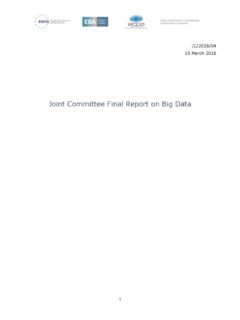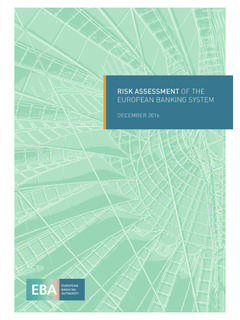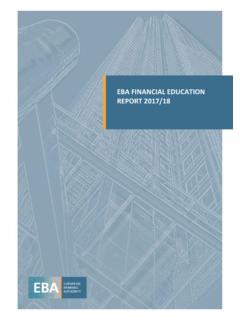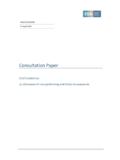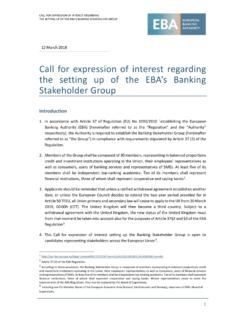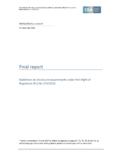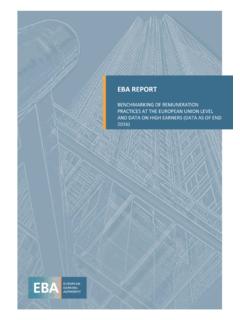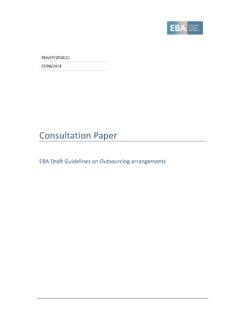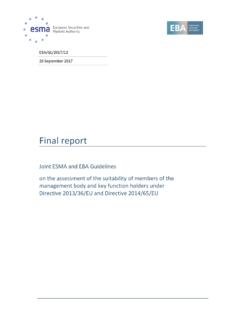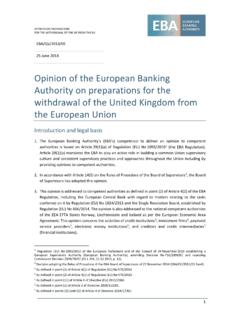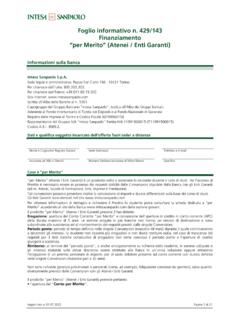Transcription of EBA REPORT
1 EBA REPORT . ON COMPETENT AUTHORITIES' APPROACHES TO. THE ANTI-MONEY LAUNDERING AND. COUNTERING THE FINANCING OF TERRORISM. SUPERVISION OF BANKS (ROUND 2 2020/21). EBA/REP/2022/08. (COVER SUBTITLE WHITE STYLE). SECOND REPORT ON COMPETENT AUTHORITIES' APPROACHES TO THE AML/CFT SUPERVISION OF. BANKS. Contents Abbreviations 2. Executive Summary 3. 1. Background and legal basis 5. Background 5. Obligations of competent authorities 5. 2. Methodology 7. 3. Risk assessment 9. Findings 9. National risk assessments 9. Sectoral risk assessments 10. Entity-level risk assessments 11. Recommendations 13. 4. AML/CFT supervision 16. Findings 16. Supervisory strategy 16. Supervisory plans 17. Supervisory practices 18. Supervisory expectations 19. Recommendations 20. 5. Tackling ML/TF risks through prudential supervision 23. Findings 23. Recommendations 25. 6. Enforcement and supervisory follow-up 27.
2 Findings 27. Recommended actions 28. 7. Domestic and international cooperation 30. Findings 30. Recommended actions 31. 8. Conclusion and next steps 33. Annex 35. List of key AML/CFT instruments mentioned in this REPORT 35. 1. SECOND REPORT ON COMPETENT AUTHORITIES' APPROACHES TO THE AML/CFT SUPERVISION OF. BANKS. Abbreviations AML Anti-money laundering CFT Countering the financing of terrorism EBA European Banking Authority EEA European Economic Area ESAs European Supervisory Authorities EU European Union FATF Financial Action Task Force FIU Financial Intelligence Unit ML/TF Money laundering and terrorist financing MONEYVAL Committee of Experts on the Evaluation of Anti-Money Laundering Measures and the Financing of Terrorism NRA National risk assessment SNRA Supranational risk assessment 2. SECOND REPORT ON COMPETENT AUTHORITIES' APPROACHES TO THE AML/CFT SUPERVISION OF.
3 BANKS. Executive summary This REPORT summarises the findings from the second year of ongoing reviews, led by EBA staff with the support of a team of national anti-money laundering and countering the financing of terrorism (AML/CFT) experts, of all competent authorities that are responsible for the AML/CFT supervision of banks in the European Union (EU) and in the European Economic Area (EEA). Over the course of 2020 and 2021, review teams assessed seven competent authorities from seven EU/EEA Member States and made recommendations tailored to each competent authority to support their AML/CFT. work. They also assessed how prudential supervisors in these Member States tackled ML/TF risk in line with their supervisory remit and scope. Competent authorities that have not yet been reviewed will be assessed during the next evaluation rounds. This REPORT describes how competent authorities in this period's sample apply the risk-based approach set out in international standards, Directive (EU) 2015/849 and AML/CFT guidelines issued jointly by the European Supervisory Authorities and the EBA.
4 It focuses on how these competent authorities assess the money laundering and terrorist financing (ML/TF) risks associated with banks under their supervision, and on how competent authorities are using these risk assessments to inform their supervisory practice and enforcement. It also sets out how these AML/CFT competent authorities interact with their prudential counterparts and other stakeholders to ensure a comprehensive supervisory approach to tackling ML/TF and safeguarding the integrity of the financial markets in their jurisdiction. For each topic, this REPORT summarises recommendations that the review team issued to competent authorities. These recommendations may also be relevant to other competent authorities responsible for the AML/CFT supervision of financial institutions across the single market. As was the case in the first round of reviews that took place in 2019, EBA staff found that all competent authorities in the EBA's sample had undertaken significant work to implement a risk- based approach to AML/CFT.
5 AML/CFT supervisory staff in all competent authorities had a good understanding of international and EU AML/CFT standards and were committed to the fight against financial crime. Several competent authorities had made tackling ML/TF one of their key priorities, and in many cases reforms were underway to strengthen their approach to the AML/CFT. supervision of banks. Since the last round of reviews, supervisory cooperation had become a clear focus for all competent authorities in this year's sample, and all competent authorities had started to put in place mechanisms to exchange information with other relevant authorities at home and abroad such as memoranda of understanding and AML/CFT colleges. Nevertheless, as was the case during the first round of reviews, competent authorities continued to face challenges in operationalising the risk-based approach to AML/CFT.
6 Some of these challenges were unique to individual competent authorities and related to, for example, geographical factors such as their sector's exposure to customers from higher ML/TF risk third countries, or the lack of adequate powers that hampered their ability to execute their functions effectively. But some challenges were common to most competent authorities in this year's sample. 3. SECOND REPORT ON COMPETENT AUTHORITIES' APPROACHES TO THE AML/CFT SUPERVISION OF. BANKS. Common challenges included difficulties relating to the identification and assessment of ML/TF. risks associated with the banking sector and with individual banks within that sector, in particular in relation to TF risk; translating ML/TF risk assessments into risk-based supervisory strategies;. using available resources effectively, including by ensuring sufficiently intrusive on-site and off-site supervision; and taking proportionate and sufficiently dissuasive enforcement measures to correct AML/CFT compliance weaknesses.
7 The review team also found that cooperation with FIUs was not always systematic and continued to be largely ineffective in most Member States in this year's sample, though several competent authorities had started to take steps to address this. Overall, while these challenges hampered the effectiveness of aspects of competent authorities'. approaches to AML/CFT supervision, change was underway and the review team found that most competent authorities were on course to tackle ML/TF risks more effectively, holistically and comprehensively. 4. REPORT ON COMPETENT AUTHORITIES' APPROACHES TO THE AML/CFT SUPERVISION OF BANKS. 1. Background and legal basis Background 1. The EU has a comprehensive legal framework to tackle ML/TF. This framework is evolving in line with international AML/CFT standards and best practices. 2. There has, nevertheless, been a constant stream of high-profile ML/TF cases involving European banks.
8 These scandals, together with findings by international AML/CFT. assessment bodies that point to deficiencies in some competent authorities' approaches to the AML/CFT supervision of banks, have led to suggestions that competent authorities should do more to ensure that the EU's AML/CFT framework is implemented consistently and effectively. 3. In 2018, the EBA therefore decided to review the effectiveness of national competent authorities' approaches to the AML/CFT supervision of banks, and to support individual competent authorities' AML/CFT efforts. The first round of reviews took place during 2019. The second round of reviews was scheduled to take place in 2020 but was postponed by several months due to the restrictions on movement and associated operational challenges for competent authorities that were caused by the global pandemic. 4. The legal basis for the EBA's implementation reviews is set out in Article 1, Article 8(1), Article 9a as well as Article 29(1) and (2) of the EBA Regulation, which confers on the EBA a duty to ensure effective and consistent supervisory practices, to contribute to the consistent and effective application of Union law and to contribute to preventing the use of the EU's financial system for ML/TF purposes.
9 To this effect, the EBA can carry out peer reviews and investigate potential breaches of Union law, and it can take other measures such as staff-led implementation reviews to assess competent authorities' responses to particular compliance challenges. Obligations of competent authorities 5. Directive (EU) 2015/849 on the prevention of the use of the financial system for the purposes of money laundering or terrorist financing aims, inter alia, to bring EU legislation into line with the International Standards on Combating Money Laundering and the Financing of Terrorism and Proliferation that the Financial Action Task Force (FATF), an international AML/CFT standard-setter, adopted in 2012. 6. In line with the FATF's standards, Directive (EU) 2015/849 puts the risk-based approach at the centre of the EU's AML/CFT regime. It recognises that ML/TF risks can vary and that Member States, competent authorities, and credit and financial institutions within its scope 5.
10 REPORT ON COMPETENT AUTHORITIES' APPROACHES TO THE AML/CFT SUPERVISION OF BANKS. have to take steps to identify and assess these risks with a view to deciding how best to manage them. 7. Article 48(10) of Directive (EU) 2015/849 requires the European Supervisory Authorities (ESAs) to issue guidelines to competent authorities on the characteristics of a risk-based approach to AML/CTF supervision and the steps that competent authorities should take when conducting AML/CFT supervision on a risk-sensitive basis. 1 The aim is to create a common understanding of the risk-based approach to AML/CFT supervision and to establish consistent and effective supervisory practices across the EU. In these guidelines, which were first issued in 2016, the ESAs characterise the risk-based approach to AML/CFT. supervision as an ongoing and cyclical process that consists of four steps, namely the identification of ML/TF risk factors; the assessment of ML/TF risks; the allocation of AML/CFT supervisory resources based on the outcomes of this risk assessment, including decisions on the focus, depth, duration and frequency of on-site and off-site inspections, and on supervisory staffing needs; and the monitoring and review of both the risk assessment and the underlying methodology.
